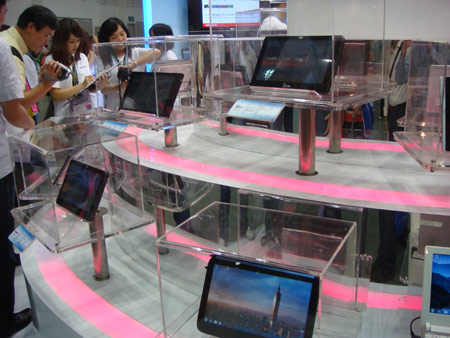Computex 2010: Year of the tablet?

Computex, which is Asia's largest tech show, has a different theme each year. In 2008, it was netbooks. Last year it was ultra-thin laptops. This year was supposed to be the year of the tablet, but it hasn't really turned out that way.
That's not to say tablets aren't a big presence here in Taiwan. There's certainly lots of talk of tablets and in fact there are plenty of tablets, but nearly all of them are prototypes. In many cases, these tablets don't even boot up-they're just slabs sitting safely behind glass. Real tablets that you can actually touch and try out are few and far between.
Many people at the show attribute this to the iPad effect. Major PC and consumer electronics companies were preparing to release tablets earlier this year, but Apple's iPad forced them to go back to the drawing board. There's some anecdotal evidence to support that idea. For example, HP has clearly been recalibrating its tablet plans and Microsoft killed off its Courier project.
But the real snag is that the chipsets and software simply aren't yet in place to support competitive tablets. Intel recently released its Moorestown platform, which is designed for Android and MeeGo, a Linux-based operating system it is jointly developing with Nokia, but neither operating system is ready for tablets. Microsoft is focused on Windows 7 for tablets, but Moorestown doesn't support it, which means companies must either use the older Menlow platform or wait until Oak Trail is available in early 2011. In the ARM camp, there are several chip companies developing good tablet platforms, most notably Qualcomm's Snapdragon, which can be used on tablets with Android, other Linux-based operating systems or Windows Embedded Compact 7. But even ARM concedes that getting all the software pieces in place to support key technologies such as Adobe Flash has been a long, difficult process. Finally Google has said Chrome OS will work with tablets, as well as netbooks, but that operating system won't debut until late 2010.
All of this for now puts competitors at a disadvantage to Apple, which of course tightly controls every aspect of the iPad from the processor to the operating system to the applications store. But it hasn't deterred them from showing off new designs. Here are some of the more interesting tablets from the show floor.
At its press conference earlier in the week, Asus announced two tablets, the 10-inch Eee PC EP101TC and the 12-inch EP121. Both were stuck behind glass at the Asus booth, where the company was also showing off an Eee Tablet e-book reader with a 6-inch E-Ink display. The EP101TC will use Nvidia's Tegra 2 processor and will run Windows Embedded Compact 7. It will come with up to 64GB of memory and 802.11b/g/n, but not wireless WAN. The EP121 is basically a laptop without a keyboard. The 12-inch tablet will use an ultra low-voltage dual-core Intel processor, Windows 7 Home Premium, 2GB DRAM, up to 128GB of storage and 802.11b/g/n. Asus said the Eee Pads won't be available until early 2011 and will be priced from $400 to $500. Asus was also showing a hybrid model with a detachable keyboard, much like Lenovo's U1 hybrid PC.
Like Asus, MSI apparently plans to release both Intel and ARM-based versions of its Wind Pad. But at its booth the company was showing only the Wind Pad 100 has a 1.66GHz Intel Atom Z530 processor, 2GB of memory, 32GB of storage, 802.11b/g/n and Windows 7 Home Premium with MSI's own Wind Touch UI. It will ship later this year for $500. MSI said it is also working on a Tegra 2-based tablet running Android 2.1, called the Wind Pad 110, but it isn't clear when this version will reach the market.
The Acer Stream, like the Dell Streak, is more smartphone than tablet. The Stream uses the same 1GHz Snapdragon processor, but it has an even smaller 3.7-inch AMOLED display, as well as Android 2.1. For storage it relies on a microSD slot that supports up to cards up to 32GB. Acer says the Stream's Snapdragon processor and 5MP camera let you record and playback 720p video with the Stream.
Computex left no doubt that the industry is gearing up to compete with Apple on tablets, but the next Consumer Electronics Show, in January 2011, is shaping up to be the real tablet coming-out party. The battle won't really start until early 2011 when many of these Android and Windows 7 tablets become available.
